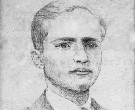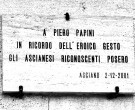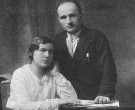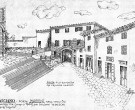> Home > What to visit > Palaces and Monuments

Lapide a ricordo di Pierino Papini e del suo eroismo Asciano
PALACES AND MONUMENTS
.jpeg)
PHONE NUMBERS AND TIMES
Lapide a ricordo di Pierino Papini e del suo eroismo
53041 ASCIANO Piazza della Basilica, 1
Business card (vCard)
The commemorative stone of Pierino Papini was placed on the corner of the reconstructed building of the Bank in December 2001, thanks to the sensibility of the mayor then in office and to a small group of citizens who love local history.
For the great heroic gesture that Papini made in the night between 27 and 28 June 1944 managing to save the Collegiate, it is surprising that no one had thought of it before, but his great modesty and the widespread desire to move on after the war, led fellow citizens to quickly forget the debt of gratitude they still owe to this brilliant young stonemason.
Pierino Papini was born on September 10, 1905, from a couple of local artisans who shared a single shop, although doing different activities: he was a watchmaker and she was a weaver.
At school age, this only son of the couple proved to be very good at learning but nevertheless his studies ended with the fifth grade. His parents, tireless workers, did everything to include him in the activity of their shop but Piero, always curious to learn new things and determined to choose his own future freely, ended up being a stonemason in the travertine quarries of the Serre.
Here he immediately made himself known for his intelligence and manual ability, so much so that he soon became responsible for important and particularly complex projects.
Having achieved job stability, Piero thought of starting a family by marrying Alfierina Ferri on March 28, 1932. The couple had three children in a short time: two girls and a boy.
Meanwhile, Papini never missed an opportunity to deepen his knowledge of architecture and sculptural art.
When, at the end of the passage of the retreating German front, he found himself defending the population and the country as best he could from possible and inconceivable destruction of buildings, he did not hesitate to take bold decisions in their defense.
In addition to carrying out functions of support and information connection between CLN and Partisan Bands, he worked continuously to procure basic necessities for fellow citizens in difficulty. But his great artistic sensitivity led him to take care of the defense of historical and artistic assets belonging to the community.
When at the end of June 1944, in the terminal phase of the German retreat, the enemy's intention to blow up a series of public and private buildings was feared, formally to hinder the advance of the Anglo-Americans, but more probably for revenge against the " Italian traitors", Pierino jumped straight into action.
After trying to raise awareness among the frightened population, to mobilize to defend their urban heritage, he decided to act personally, with the sole support of two Partisan friends: Orazio Trapassi and Guido Lorenzoni.
Not being able to intervene in defense of all the mined buildings, he worked to save Porta Massini and the Collegiate Church. With fuses already lit to blow up the two buildings and in the presence of the Germans, he planned and implemented the way to cut the flaming fuses before they triggered the mines. Despite the high probability of being killed, Pierino completed his plan which, even if partially failed, saved the millennial church and many other surrounding buildings. Unfortunately the mines outside Porta Massini exploded due to their damaged but not completely interrupted fuse.
About a month and a half later, on 16 August 1944, Pierino Papini found himself alone raising his three children, due to the death of his beloved wife from tuberculosis, an incurable disease at the time.
The great pain for the fatal event and the many difficulties to face, deeply marked our hero: both physically and in spirit, so much so that less than 4 years later, on January 10, 1948, he disappeared leaving astonished relatives, friends and fellow citizens.
STAY NEARBY
LA PACE
ASCIANO
The "La Pace" hotel is located in Asciano, a village in the heart of the Crete S...SAN SEBASTIANO
ASCIANO
5 minutes on foot from the village of Asciano and near Siena, in the heart of the Crete Se...COSTA REGOLI
ASCIANO
Newly built farmhouse, set in the open countryside and away from noise. Location within wa...DINING & ENTERTAINMENT NEARBY
La GARBATA Pasticceria Gelateria
ASCIANO
Local open since May 2018: new as a commercial building, it is characterized by a modern a...Ristorante L'Angolo dello Sfizio
ASCIANO
The Angle of Sfizio is located in the main street of the old town of Asciano. The resta...Bar GASTON di Davide Manieri & C.
ASCIANO
New place run by young people, for young and "differently young" people. &nbs...






